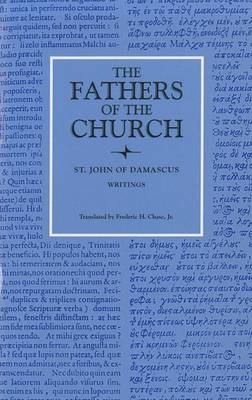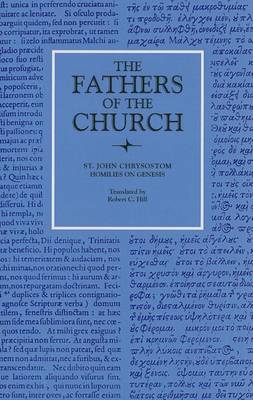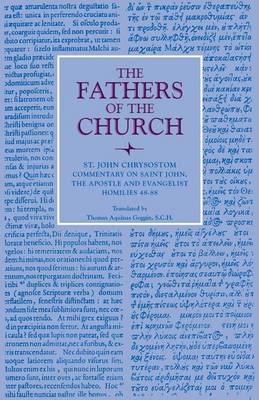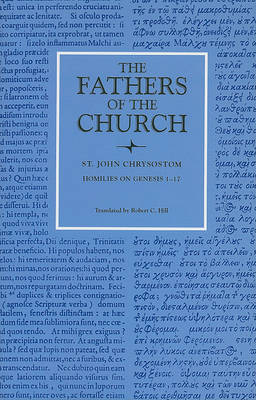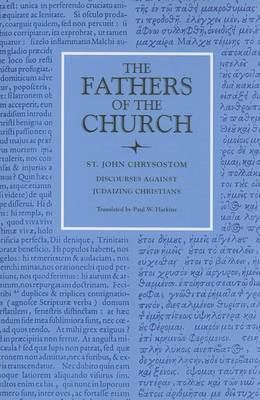Fathers of the Church
7 total works
Ten of the twelve homilies of St. John Chrysostom presented here were delivered at Antioch over a period of several years beginning in A.D. 386. The final two homilies were delivered in 398 after Chrysostom became patriarch of Constantinople.
All but one of the homilies aim at refuting the Anomoeans, heretics who revived the most radical tenets of Arius and blatantly claimed that man knows God in the very same way that God knows himself. Chrysostom's refutations and instructions to the faithful are based on the Scriptures rather than on human reasoning. He departed from this series of refutations only in the sixth homily, which he delivered on December 20, 386, again at Antioch. It consists of a panegyric of St. Philogonius, bishop of Antioch ca. A.D. 319-23, who before his episcopal ordination had led a very exemplary life, practiced law and contracted a marriage that was blessed with a daughter.
In addition to their theological content, these homilies contain many other points of interest. On one occasion, people applauded the speaker and were very attentive to the homily but then left the church so that when Christ is about to appear in the holy mysteries the church becomes empty (Hom III.32; Hom VII.2). During another homily, pickpockets plied their trade so that Chrysostom urged "let no one come into the church carrying money" (Hom IV.46). Chrysostom also indicates that people kept talking to one another at the sacred moment when Christ becomes present (Hom IV.36). He also mentions that chariot races often proved more enticing than going to church (Hom VII.1). Finally, valuable information on fourth-century Eastern liturgies is found in Hom III.41, 42, and Hom IV.32.
Chrysostom's work reveals that repentance is an indestructible pillar of the All-Holy, Universal and Immutable Church of Christ. He believed that repentance is the liturgical tool that rejuvenates sinners and admits them into the life-giving Eucharist where they experience fully and dynamically the concrete presence of God.
The powers of repentance have rich biblical roots, and Chrysostom masterfully weaves his teaching with a plethora of Old and New Testament citings. From Scripture, the reader learns that repentance is never confined to the eucharistic context-it becomes a way of life for the believer. The daily applications of repentance, such as almsgiving, fasting, remorse over personal sins, humility, prayer, and attending Church, suggest that a person's entire life has an ecclesial character. Chrysostom preached that the whole experience of a true life in Christ is repentance that culminates in metanoia-the total change and renewal from the heart and mind of sin to "the mind of Christ" (1 Cor. 2:16).
In his introduction to the homilies, Fr. Gus Christo includes a succinct biography of Chrysostom within which he sets the homilies in their chronological context. He also provides an overview of repentance and discusses the ecclesiological nature of Chrysostom's theology.
Gus George Christo is a priest of the Greek Orthodox Archdiocese of America, under the spiritual direction of the Ecumenical Patriarchate of Constantinople, and is currently a pastor of the Greek Orthodox Church of the Holy Trinity in Lansing, Michigan. He received his B.A. in religious studies from the University of Virginia and his M.A. and Ph.D. in theology from the University of Durham, England. This volume is part of Fr. Christo's ongoing research and translation of the works of early Church Fathers, especially the works of St. John Chrysostom.
St. John of Damascus (ca. 675-749) is generally regarded as the last great figure of Greek Patrology. Outstandingly important for his support of images in the Iconoclastic Controversy, this priest-monk of St. Sabbas near Jerusalem is known also for his treatment of Christian morality and asceticism (the Sacred Parallels), for a small but precious group of powerful sermons, and even for verse contributions to the Greek liturgy. His reputation rests mainly, however, on one of his latest writings, the Fount of Wisdom. This relatively brief work is called by the late Fr. Chase, its new translator, "the first real Summa Theologica"; and its most significant section was in fact known, in Latin translation, to Peter Lombard and St. Thomas Aquinas.
The first part of the Fount of Wisdom, "Philosophical Chapters" ("Dialectica"), goes back to Aristotle mainly and, through Maximus the Confessor, to Plato. Epiphanius is the chief source of Part Two, with its exposition of 103 heresies. The third and most important section of the work, "On the Orthodox Faith," is a comprehensive presentation of the teaching of the Greek Fathers on the main doctrines of Christianity, especially the Trinity, Creation, and the Incarnation. But what emerges is not a compilation but rather a synthesis, marked by originality in the mode of treatment and by a remarkable clarity of expression. In all three of its parts the Damascene's Fount of Wisdom is "an indispensable aid to the study of the Greek Christian tradition."
St. John Chrysostom delivered his Homilies on Genesis sometime between A.D. 385 and A.D. 388, while yet a priest at Antioch. In the homilies in this volume, the last of three, Chrysostom concludes his examination of the lives and virtues of the Old Testament patriarchs Abraham, Isaac, Jacob, and Joseph as recounted in the last three chapters of Genesis.
Known for his eloquent preaching, Chrysostom delivered these final twenty-two homilies after Pentecost. His motive for examining the accounts of the lives of the patriarchs is to show how the just forebears of the Israelites, in a time when both the law and the Gospel were yet unpreached, were able to live Christian lives with only simple trust in God and the balanced, almost ingenuous manners of antiquity. His interest in the events and characters of Genesis is largely moral, even moralistic; he tends to see Scripture as hagiography. His style of commentary, although not really thorough exegesis, arises out of his deep conviction of the divine inspiration of Scripture--hence the habitual attention to detail, "not idly or to no purpose" being his frequent comment on the precision of the text.
As an exegete, Chrysostom may seem disappointing to those grounded in the methods of modern biblical scholarship, since he largely ignores any sense of Scripture other than the literal and is generally unaware of how to resolve difficulties and appreciate subtleties that a knowledge of the original text would provide. However, what lacks in scientific accuracy he more than compensates for with his earnest practice of pastoral care.
This final volume of the homilies includes a general index and an index of biblical citations, the latter indicating the rich scriptural diet Chrysostom's congregation--who came daily for his homilies--enjoyed.
The Homilies on St. John's Gospel come from the period in which Chrysostom attained his greatest fame as pulpit orator, the years of his simple priesthood at Antioch (386-397). This was the peaceful period in Chrysostom's life that preceded his elevation to the episcopacy as patriarch of Constantinople (398), wherein adverse imperial and ecclesiastical reaction to his program of moral reform led to his deposition, banishment, and all but martyr's death (407).
The 88 Homilies, which date from about 390, work systematically through the text of St. John's Gospel and thus form a commentary upon it. In his exposition Chrysostom reflects his youthful Antiochene training in the interpretation of Holy Scripture through his emphasis upon the literal or historical meaning of the sacred text. The exposition focuses sharply on practical morality and thus often supplies telling information about fourth-century life and times. The homilies show the flowering of Chrysostom's intensive study of rhetoric and are especially commendable for their command of imagery. The first 47 Homilies carry Chrysostom's commentary through Chap. 6.54-72; the remaining 41, extending the commentary through to the end of the Gospel, are contained in Vol. 41 of this series.
The Genesis homilies, his richest Old Testament series, reveal a theologian, pastor, and moralist struggling to explain some of the most challenging biblical material to his congregation in Antioch. He admonishes them to "apply yourself diligently to the reading of Sacred Scripture, not only when you come along here, but at home," encourages spiritual discourse, and frequently envisages them leaving church reminiscing on the day's sermon. While critical exegetical details go without mention and Chrysostom was limited to the Greek version of the Old Testament in his studies, his oratory has been judged golden and his theology profound. He was a preacher satisfied with commenting on Scripture with his moral purpose always to the fore.
Chrysostom studied the Scriptures with Diodore of Tarsus, a distinguished exegete known from fragments of his commentaries on Genesis and Psalms, and a polemic style developed from his pastoral concern to protect his congregation from the dangerous influences of fourth-century Antioch. Most importantly, he shared the Antiochene school's insistence on the literal sense of Scripture and their unwillingness to engage in allegorical interpretation. As such, his Genesis homilies constitute a milestone in the history of biblical interpretation.
This first of several volumes on Genesis contains homilies 1-17, delivered in Antioch before Chrysostom moved to Constantinople in 398. Robert C. Hill's thorough introduction highlights Chrysostom's significance as a scriptural commentator and provides the basis for an interesting comparison with modern commentators, such as Von Rad and Speiser.
St. John Chrysostom's Discourse Against Judaizing Christians are eight homilies or sermons with a unifying theme: the correction of certain abuses in a fourth-century Christian community. Judged by modern tastes the Discourses may seem lengthy, and Chrysostom himself admits that they taxed his energies when he complains of having become hoarse. In Antioch of the late fourth century two highly divisive forces contributed to deteriorating Judaeo-Christian relations: very successful Jewish proselytizing, and Christian Judaizing. Both activities profoundly disturbed a vigilant leader and eloquent preacher such as Chrysostom was.
These Discourses, frequently interrupted by applause from the audience, present in their historical context one facet of the deteriorating relations. Antedating Chrysostom by some two centuries, emerging views that the Jews were a people cursed and dispersed in punishment for their unbelief and deicide were gaining credence; witness some statements by Irenaeus in Lyons and Tertullian in northern Africa. In the course of time certain passages of sacred Scripture began to be reinterpreted, when occasion presented itself, in such a way as to endow the polemics with divine authority.
A simplistic view of the complex problem of anti-Semitism raised the cry, almost a century ago, that the Church nurtures hatred against the Jews and at the same time protected them from the fury she had unleashed. However, on October 28, 1965 Vatican Council II issued a decree: Declaration on the Church's Attitude Toward Non-Christian Religions (cf. Acta apostolicae sedis 58 (1966) 740-44). Therein the Council officially re-affirmed the common religious patrimony of Jews and Christians. It clearly rejected any alleged collective guilt of the Jewish people for the death of Christ and their alleged rejection of God.


